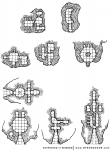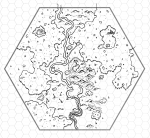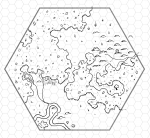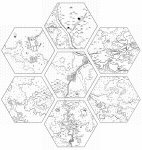
Some cities just stink. Built over drained swampland and mostly relying on surface sewers, Uogralas is unfortunately one of the smellier urban centres of the land.
Uogralas is known as the City of the Frogs because of its swampy origins and the city's patron god, Ugrale, a great toad-like deity dedicated to brickwork, construction, and the hearth. The city is ostensibly run by Duke Sooryakan, who in turn basically runs everything past Prefect Sahint of the church of Ugrale because no edict of the Duke's will have any effect without the support and enforcement of the religious police.
Just north of the city is the walled Monastery of Raised Delights, home to a splinter group of the church of Ugrale who are exiled from the city, but otherwise accepted as long as they have no involvement in the city's politics.
Uogralas primarily exports marsh grains, a crisp watery tuber, lizard leathers, bricks, and spices collected from exotic flowers. They import lumber for boats and construction and for use as fuel, as well as meats, cheeses, and metals.







